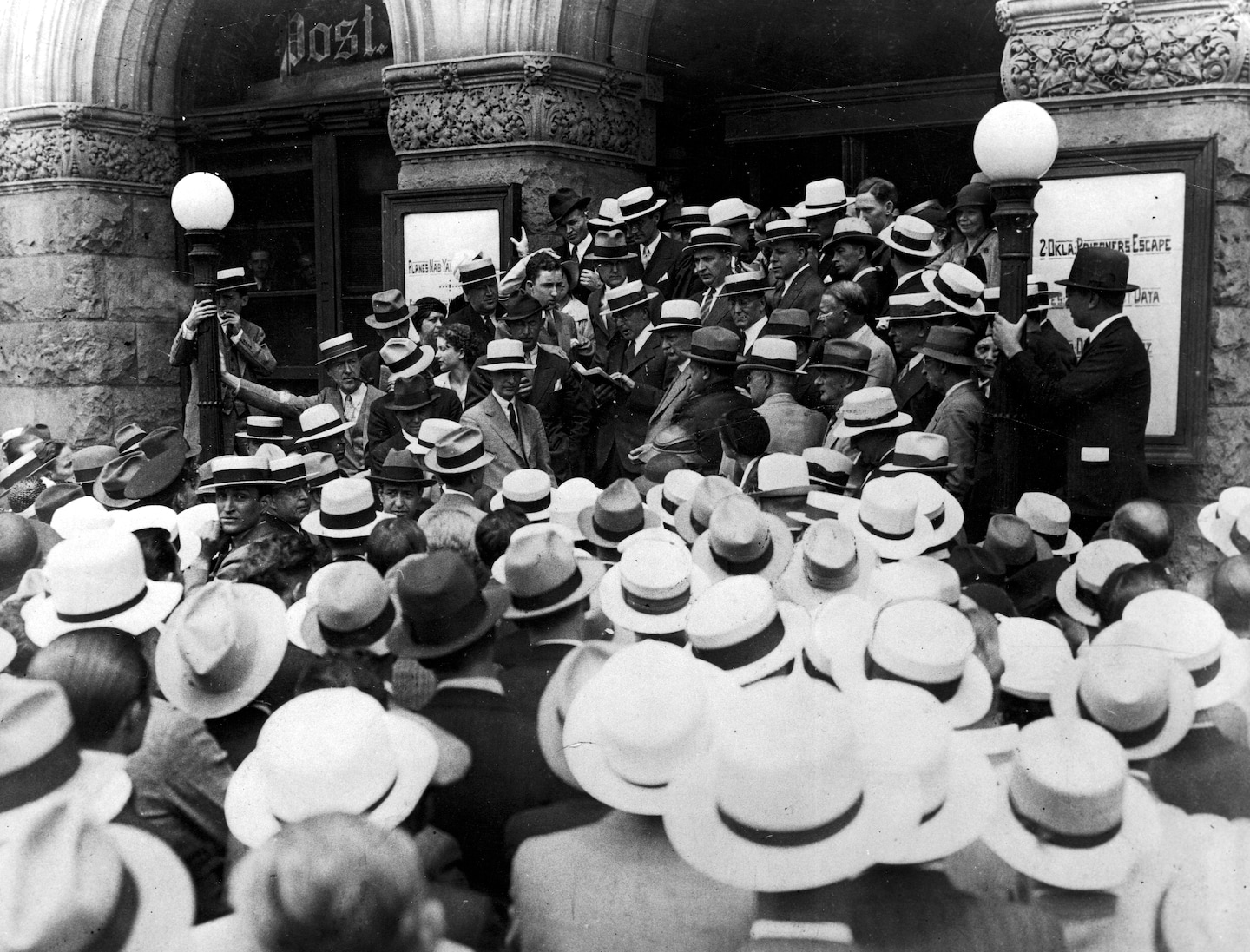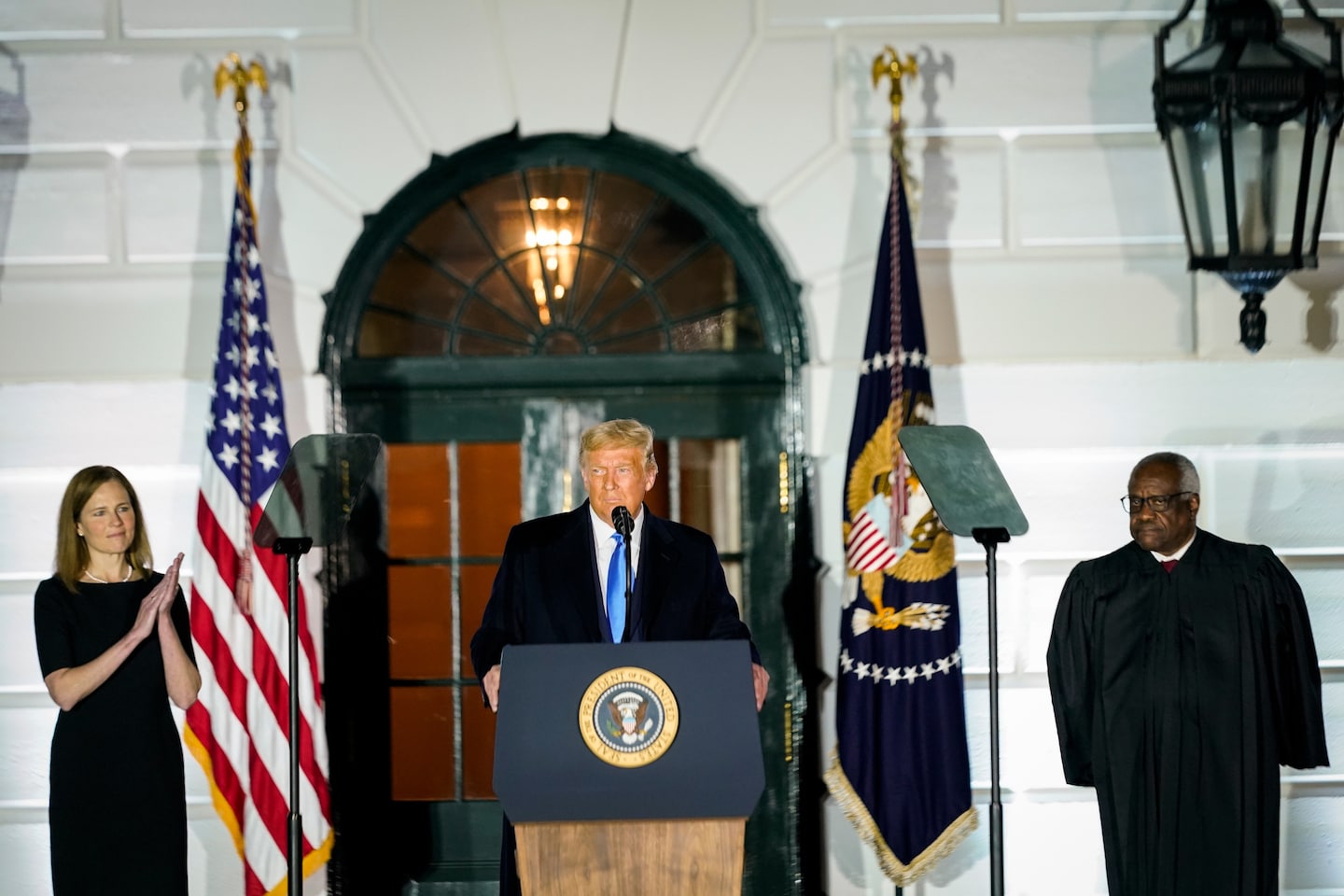
1880: The Post published its first Sunday edition. Joseph Pulitzer wrote for The Post when he was temporarily in Washington, and the then relatively unknown Theodore Roosevelt contributed a series of western stories to The Post that appeared without his byline.
1888: Hutchins purchased the Daily Republican, at that time The Post’s sole morning competition, and launched The Evening Post in the only attempt ever made by The Post to publish an afternoon edition.
1889: Hutchins sold The Post to Frank Hatton, a Republican Cabinet member, and Beriah Wilkins, a former Democratic congressman. On June 15, at an essay awards ceremony on the National Mall, United States Marine Band leader John Philip Sousa introduced “The Washington Post March,” which he wrote especially for the newspaper. It became an immediate popular hit and is still a marching band favorite today.
1893: Hatton and Wilkins moved The Post to a new building at 1335 E St. NW, next to the National Theatre.
1905: John R. McLean, owner of the Cincinnati Enquirer, bought the newspaper. Under his leadership, The Washington Post increased its circulation and advertising and boosted its profits, but McLean’s loyalty to the Democratic Party colored his news judgment and caused the paper to lose much of its credibility and influence.
1916: McLean died and his son, Edward, became publisher. A crony of President Warren G. Harding, young McLean switched the paper’s allegiance to the Republican Party. Circulation dropped, advertising decreased and finally The Post stumbled into receivership.
1933: On June 1, a public auction was held on the steps of The Post’s E Street Building and the newspaper was sold for $825,000 to Eugene Meyer, a California-born financier. Meyer was not an experienced newspaperman, but he had strong convictions about publishing a newspaper which he expressed in this set of principles:
- The first mission of a newspaper is to tell the truth as nearly as the truth may be ascertained.
- The Newspaper shall tell ALL the truth so far as it can learn it, concerning the important affairs of America and the world.
- As a disseminator of the news, the paper shall observe the decencies that are obligatory upon a private gentleman.
- What it prints shall be fit reading for the young as well as for the old.
- The newspaper’s duty is to its readers and to the public at large, and not to the private interests of its owners.
- In the pursuit of truth, the newspaper shall be prepared to make sacrifices of its material fortunes, if such course be necessary for the public good.
- The newspaper shall not be the ally of any special interest, but shall be fair and free and wholesome in its outlook on public affairs and public men.
1933-1943: Meyer’s enlightened editorial policies and his business acumen began to turn The Washington Post around. In the first 10 years after he took over, circulation tripled to 162,000 and advertising soared from 4 million to 12 million lines.
1946: President Harry S. Truman appointed Meyer the first president of the International Bank for Reconstruction and Development. Meyer was succeeded at The Washington Post by Philip L. Graham, his son-in-law, who had been assistant publisher.
Philip Graham (1946-1963)
1948: The Washington Post Co. acquired controlling interest of WTOP radio in Washington, D.C.
1950: To accommodate the growing newspaper, Graham built a new $6 million plant for The Washington Post at 1515 L St. NW, installing up-to-date presses and other new equipment. On June 20, he purchased Washington’s CBS television station and changed the call letters to WTOP-TV.
1953: The Washington Post Co. purchased television station WMBR in Jacksonville, Fla., and later (1958) changed the call letters to WJXT-TV.
1954: The Washington Post Co. purchased its last morning rival in the city, the Washington Times-Herald. Circulation of The Washington Post and Times-Herald jumped almost overnight to 380,000.
1959: Upon the death of Meyer, Graham became president and publisher of the newspaper.
1961: Graham purchased Newsweek magazine for The Washington Post Co.
1962: The Los Angeles Times-Washington Post News Service was formed to syndicate columns, articles and features appearing in both newspapers. Today, with more than 650 domestic and foreign clients, it is one of the largest supplemental news services in the world.
Katharine Graham (1963-1981)
1963: Katharine Graham became president of The Washington Post Co. following the death of her husband, Philip Graham. The Washington Post Co. bought 49 percent of the common stock of Bowater Mersey Paper Co. in Nova Scotia, Canada.
1966: On Sept. 1, The Washington Post purchased an 85 percent interest in the Robinson Terminal Warehouse in Alexandria, Va. The warehouse is used as a storage place for newsprint for The Washington Post and other publications in the area.
1969: The Washington Post Co. purchased the ABC-affiliated television station in Miami and changed the call letters to WPLG-TV in honor of the late Philip L. Graham.
1970: The Washington Post became one of the first newspapers in the country to appoint an “ombudsman” on its news staff. In addition to being the readers’ advocate, The Post’s ombudsman monitored and commented upon the media in general and The Washington Post in particular. In March, The Post’s daily circulation topped half a million for the first time.
1971: On June 15, The Washington Post Co. offered the sale of Class B common stock to the general public. Until then The Post Co. had been privately held. Its stock was listed on the New York Stock Exchange. On June 18, The Washington Post began publishing excerpts of the “Pentagon Papers” containing allegedly secret information about the war in Vietnam. On June 30, the U.S. Supreme Court upheld the right of The Post and other newspapers to publish the Pentagon Papers. In ceremonies at Howard University in Washington, D.C., Katharine Graham donated radio station WTOP-FM to the university “to stimulate the intellectual and cultural life of the whole community and to train more people for the communications industry.” On Dec. 6, with the new call letters WHUR-FM, the station became the first under Black management to broadcast in the Washington metropolitan area.
1972: The Post’s news staff began its coverage of the Watergate scandals that eventually contributed to the resignation of Richard M. Nixon as U.S. president. On Oct. 16, an addition to The Washington Post’s building was dedicated, doubling the total work area to more than half a million square feet.
1973: Katharine Graham was elected chairman of the board and chief executive officer of The Washington Post Co. while continuing as publisher of The Washington Post newspaper. In September, The Post formed The Washington Post Writers Group to syndicate articles and publish books. Today, over 30 nationally recognized columnists, including Carolyn Hax, David Ignatius, Kathleen Parker, Michelle Singletary and George Will, are now syndicated, reaching more than 700 unique clients.
1974: On March 8, The Washington Post Co. purchased WSFB-TV in Hartford, Conn.
1975: The Washington Post launched three new weekly zoned sections, the Maryland, District and Virginia Weeklies. Each Weekly is distributed only in its designated area as part of the regular Thursday Washington Post. The Weeklies provide greater coverage of community news, activities and features of special interest to readers living in the regions served.
1976: After working at The Post in various editorial, production and executive capacities, Donald E. Graham, Katharine Graham’s son, was appointed executive vice president and general manager of the newspaper.
1977: The Washington Post celebrated the 100th anniversary of its founding. The newspaper’s Sunday supplement, Potomac Magazine, became The Washington Post Magazine, and a new Friday tabloid section, Weekend, was begun. In November, The Washington Post Co. announced the sale of its one remaining radio station, WTOP-AM.
1978: The Washington Post Co. purchased the Everett (Washington) Herald, a daily newspaper north of Seattle. Later, The Post Co. announced an agreement to participate in a limited partnership with Dow Jones & Co. and the Bato Co. to construct and operate a newsprint mill near Richmond, Va. In July, The Washington Post Co. exchanged television station WTOP-TV in Washington, D.C., for WDIV-TV in Detroit.
1979: Donald Graham became publisher of The Post, succeeding his mother, who retained her corporate positions of chairman of the board and chief executive officer of The Washington Post Co.
1980: On April 14, The Washington Post began publishing each Monday a financial tabloid section called Washington Business. The new section added approximately 15 columns of news and tables to the Monday business and finance pages that it replaced.
Cold-type conversion: In October, the paper’s printing process was converted from the hot-type method to photo-electronic or cold-type composition. The new method uses video display terminals (VDTs) to write and edit stories. Then copy is automatically photoset in the composing room and pasted down on layout sheets, eliminating the use of linotype machines and metal chases from which heavy metal plates were made. The first complete cold-type edition of The Washington Post rolled off the Springfield plant presses on Oct. 6.
Satellite printing plant: To accommodate The Post’s growing circulation and conversion to cold type the $60 million Springfield, Va., satellite printing plant was formally opened Nov. 12. The 397,000-square-foot building houses four 10-unit offset presses, a revolutionary platemaking system and a computer-controlled distribution system to route newspapers into delivery trucks. The presses can produce 128-page newspapers at a rate of about 75,000 copies per hour. The Post is also printed at a second satellite facility in southeast Washington.
New platemaking process: In March 1981, The Post changed its platemaking process for its eight downtown web presses from the stereotype method, which used lead heated to about 600 degrees Fahrenheit to form a 50-pound printing plate, to a NAPP direct platemaking process. This process produces a very lightweight plastic-coated steel plate ready for the presses and provides reproduction similar to offset quality printing.
1982: The Post began publishing Washington Home on May 20. The weekly tabloid section is devoted to the home, inside and out, and features topics such as decorating, making repairs, purchasing antiques or new furniture, or landscaping a garden, among others.
1983: The Washington Post National Weekly edition was launched Nov. 7. It provides readers nationwide with access to The Post’s daily coverage of government, politics, the economy and diplomatic affairs by taking Post stories that are specially edited and redesigned in a weekly tabloid format for a national audience.
1984: The Oct. 9 edition of The Post initiated a redesign of the paper emphasizing clarity, placement and reader ease. This was the first complete redesign of the paper in 50 years.
1985: In January, The Post began publishing the country’s first newspaper section devoted entirely to health. Titled Health, the tabloid covers a broad range of health-related subjects, including medicine, fitness and psychology.
1990: In February, The Post launched a free telephone service that provided a wide variety of information to callers. Readers could hear up-to-the-minute information on stock prices, sports scores, lottery results, financial reports, weather reports including resort information, and news reports and headlines from the Associated Press. The 24-hour service was available seven days a week.
1991: Donald Graham was named chief executive officer of The Washington Post Co., while his mother retained her corporate position of chairman of the board. His new responsibilities were in addition to his continuing as publisher of The Washington Post newspaper.
1993: Donald Graham became chairman of the board of The Washington Post Co., while also retaining his responsibilities as chief executive officer. Katharine Graham assumed the position of chairman of the executive committee of The Washington Post Co., In November, The Washington Post Co. created a new subsidiary, Digital Ink Co., also known as Washingtonpost.Newsweek Interactive, to develop the company’s editorial products and businesses on the Web. WPNI’s services were available principally on the Internet and included washingtonpost.com, and Newsweek.MSNBC.com.
1994: In April, The Washington Post Co. acquired KPRC-TV, the NBC affiliate in Houston, and KSAT-TV, the ABC affiliate in San Antonio, Tex., from H&C Communications.
1996: In June, The Washington Post launched washingtonpost.com.
1997: “HealthWeek,” a production of The Post Co. in association with Maryland Public Television, premiered on PBS. In September, The Washington Post Co. acquired WCPX-TV (formerly WDBO-TV) in Orlando, in exchange for WFSB-TV in Hartford, Conn. (The station, now WKMG, was renamed again in 1998 in honor of Katharine Meyer Graham.) In October, The Washington Post announced an alliance with NewsChannel 8 to broadcast directly from The Post’s newsroom. In December, The Washington Post Co. acquired several properties from Reed Elsevier and formed Post Newsweek Tech Media Group, a leading publisher of targeted trade periodicals in government technology and business-to-business technology in the nation’s capital. The Tech Media Group also is a leading presenter of technology trade shows and conferences and operates online services.
1998: In January, WCPX-TV in Orlando changed its call letters to WKMG-TV in honor of Katharine Meyer Graham. Also in January, washingtonpost.com put 11 years of The Washington Post’s archives online.
1999: On Jan. 28, The Washington Post began printing in color on its eight new Mitsubishi offset presses in the renovated Springfield, Va., plant and the new College Park, Md., plant. The Post ceased printing at its two downtown locations; the news and business offices remain headquartered in Washington, D.C. In September, The Post Co. and Tribune Co. joined forces to create BrassRing, an online career and hiring network. The partnership includes Kaplan, Tribune Co., Gannett Co. and Accel Partners. In November, The Washington Post, Newsweek and Washingtonpost.Newsweek Interactive, MSNBC.com, MSNBC Cable and NBC News announced plans to form an alliance to share news material and technological and promotional resources.
2000: In September, Boisfeuillet Jones Jr. was named publisher and chief executive officer of The Washington Post. Donald Graham became chairman of the newspaper.
2001: Katharine Graham died on July 17 at the age of 84. In March, Alan Frank became president and chief executive officer of Post-Newsweek Stations.
2003: In August, the company launched Express, a free commuter newspaper, in the Washington, D.C., market.
2004: In May, the company bought El Tiempo Latino, a Spanish-language newspaper serving the Washington metropolitan area.
2005: In January, the company bought Slate, the online magazine, from Microsoft Corp.
2008: In February, Katharine Weymouth was named chief executive officer of Washington Post Media (The Washington Post, Express and El Tiempo Latino) and publisher of The Washington Post. In June, Hal S. Jones succeeded John B. Morse Jr. as senior vice president of finance and chief financial officer of The Washington Post Co. In September, The Washington Post Co. acquired Foreign Policy magazine. Also in September, Marcus Brauchli was named executive editor of The Washington Post, succeeding Leonard Downie Jr.
2009: Throughout the year, the print and online operations of The Washington Post were integrated.
2010: In August, The Washington Post Co. announced the sale of Newsweek to Sidney Harman. In September, Katharine Weymouth, CEO of Washington Post Media and publisher of The Washington Post, was elected a director of The Washington Post Co. On Sept. 30, Harman Newsweek LLC purchased Newsweek magazine from The Washington Post Company.
2011: In January, The Washington Post Co. launched SocialCode, which unlocks the power of social media and helps brands gather, engage, incentivize and understand users. SocialCode’s data-driven approach offers the most advanced advertising and analytics on Facebook. In May, Warren Buffett retired from the company’s board of directors after serving for 37 years. This was the last outside board of directors from which Buffett retired. In September, Shailesh Prakash was named chief information officer and vice president of digital product development at The Washington Post.
2012: In May, Emily Barr was named to succeed Alan Frank, president and CEO of Post-Newsweek Stations, at year-end. In September, Dave Goldberg, CEO of SurveyMonkey, was elected a director of The Washington Post Co.
2013: In January, Martin Baron was named executive editor of The Washington Post. On Aug. 5, an agreement was announced to sell The Washington Post newspaper and other newspaper division assets to Amazon.com founder Jeff Bezos, ending the Graham family’s stewardship of one of America’s leading news organizations after four generations. On Oct. 1, the sale of The Washington Post and other newspaper division assets was completed.
Frederick J. Ryan Jr. (2014-present)
2014: In September, Frederick J. Ryan Jr. was named publisher of The Washington Post, replacing former publisher Katharine Weymouth. In October, The Washington Post announced it would provide software and technology built in-house to the student newspapers at the University of Maryland (The Diamondback) and Columbia University (The Columbia Daily Spectator), giving them access to the same advanced digital tools and technology that The Post’s newsroom uses every day.
2015: In October, The Washington Post introduced Arc Publishing, its software-as-a-service business, and announced that Willamette Week would be the first customer to license The Post’s custom-built content management platform. In December, The Post moved to its new headquarters at 1301 K St. NW in Washington, D.C.
2016: In December, Scot Gillespie was named vice president and chief technology officer of The Washington Post to manage The Post’s engineering team and be responsible for building on the initial success of The Post’s Arc platform.
2018: In November, Miki King was named chief marketing officer of The Washington Post.
2019: In February, Joy Robins was named chief revenue officer of The Washington Post. In June, The Post announced it was entering the ad tech licensing business, commercializing its Zeus Technology suite to help publishers optimize the ad experience for the benefit of advertisers and readers. In September, The Post became one of the first publishers to add product to its masthead, naming Kat Downs Mulder vice president of product and design. In September, The Post published the last edition of its Express commuter paper.
2020: In September, Lahaja Furaha was named The Post’s first director of diversity and inclusion of The Washington Post.
2021: In February, Martin Baron retired as executive editor of The Washington Post. In June, Sally Buzbee became The Washington Post’s first woman to lead the newsroom as executive editor.






